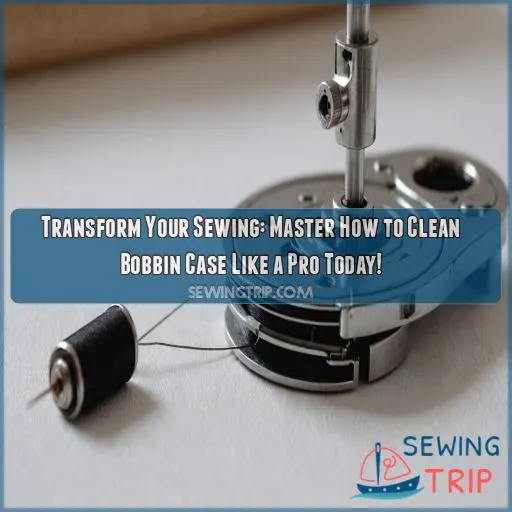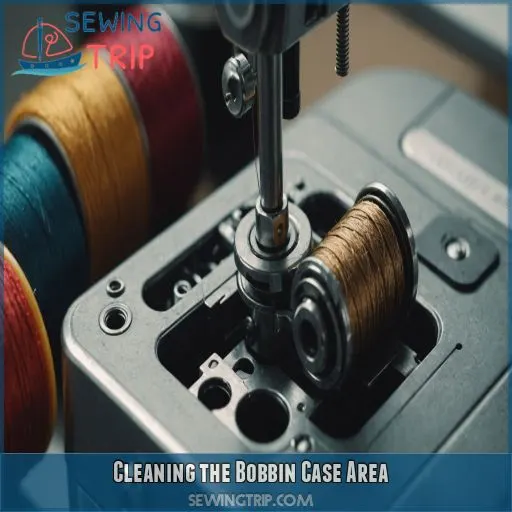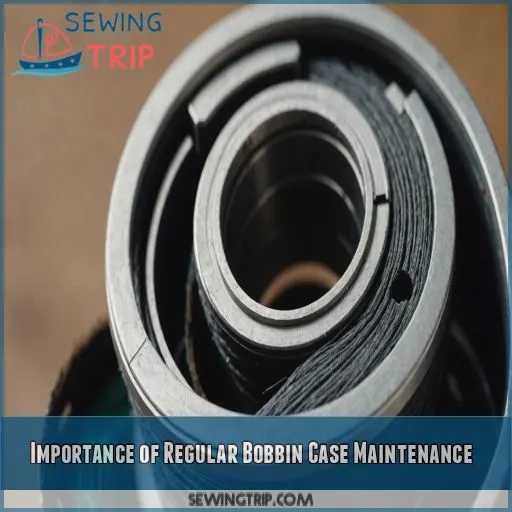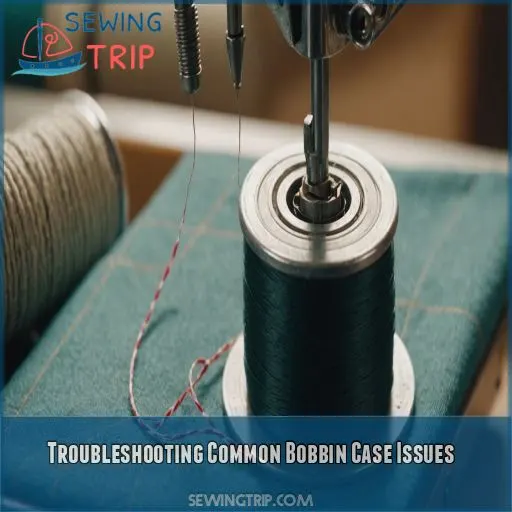This site is supported by our readers. We may earn a commission, at no cost to you, if you purchase through links.

But don’t worry, you’re about to master the art of cleaning it like a pro!
To clean your bobbin case, start by removing any visible lint and debris with your fingers or a lint removal tool.
Then, use a Soft-bristled brush to gently sweep away any remaining fluff.
Be gentle, as you don’t want to damage those delicate parts.
Clean the bobbin case spring with a cotton swab, and voila! You’re done.
Table Of Contents
Key Takeaways
- You’ll want to clean your bobbin case every 1-3 months or after 10-15 projects. Think of it like a car tune-up, but for your sewing machine. Regular cleaning prevents thread jams, tangles, and wear on your machine’s delicate parts, keeping your stitches smooth and even.
- To clean your bobbin case, start by removing any visible lint and debris with your fingers or a lint removal tool. Then, use a soft-bristled brush to gently sweep away any remaining fluff. Do not use compressed air or a vacuum cleaner, as they can push debris further in or damage the delicate parts.
- When reassembling your bobbin case, make sure the needle plate screws are securely tightened, but do not overtighten. You don’t want to cause any issues. Give the bobbin case a gentle wiggle to ensure it’s properly seated, and double-check the needle plate screws if it feels loose.
- Finally, remember that a clean bobbin case is key to preventing thread jams and tangles, extending the life of your sewing machine, and improving stitch quality. By taking a few minutes to clean and inspect your bobbin case, you can save yourself hours of frustration and ensure your sewing projects turn out beautifully.
Cleaning the Bobbin Case Area
You’re about to become a pro at cleaning your bobbin case, and trust me, your sewing machine (and your sanity) will thank you! Cleaning the bobbin case area is a really important step in keeping your sewing machine running smoothly, and with a few simple steps, you’ll be on your way to stress-free sewing.
Removing Lint and Debris
Time to tackle that pesky lint buildup in your bobbin case! You know, the one that’s been causing those annoying thread jams.
First, remove any loose debris with your fingers or a small lint removal tool.
Look for signs of lint buildup, like fluffy white clumps or tangled threads.
Cleaning frequency depends on usage, but a good rule of thumb is every 1-3 months.
Using the Right Brush for Cleaning
Cleaning your bobbin case needs the right brush. A soft-bristled brush is your go-to, gently sweeping away lint and debris without scratching delicate parts. Here are three brush types to think about:
- Soft-bristled brush: Perfect for gentle cleaning and precision work.
- Angled brush: Great for reaching into tight spaces and corners.
- Small-bristled brush: Ideal for intricate areas and small crevices.
Avoiding Damage to Delicate Parts
When cleaning your sewing machine, be gentle!
Avoid using too much pressure, as this can damage delicate parts.
Identify fragile areas, like the bobbin case’s tiny springs, and give them extra TLC.
Remember to protect these areas from oil.
Cleaning the Bobbin Case Spring
Now that you’ve avoided damaging those delicate parts, it’s time to tackle the bobbin case spring. Use a soft-bristled brush or a cotton swab to gently sweep away any lint or debris. For more stubborn grime, mix a small amount of sewing machine oil with a few drops of water, and voilà! Your spring is sparkling clean.
Importance of Regular Bobbin Case Maintenance
Regular bobbin case maintenance is important for preventing thread jams and tangles, extending the life of your sewing machine, improving stitch quality, and maintaining overall machine health (Source). By taking a few minutes to clean and inspect your bobbin case, you can make sure your sewing projects turn out beautifully .
Preventing Thread Jams and Tangles
The frustration of thread jams and tangles! You can prevent these pesky problems by regularly cleaning your bobbin case. Proper thread tension, bobbin winding, and needle type all play a role, but a clean bobbin case is key. By keeping it tidy, you’ll reduce the risk of thread catching and tangling, making your sewing experience smoother and more enjoyable.
Extending the Life of Your Sewing Machine
By keeping your bobbin case clean, you’re extending the life of your sewing machine! Regular maintenance prevents wear and tear on delicate parts, saving you from costly repairs. Think of it like car maintenance – regular tune-ups keep your machine purring smoothly. Stay on top of cleaning and oiling, and your machine will thank you with years of faithful service.
Improving Stitch Quality
Now that you’re extending the life of your sewing machine, let’s talk stitch quality.
A clean bobbin case is vital for maintaining consistent tension, which is essential for even stitches.
Think of it like baking a cake – the right ingredients (thread, needle, fabric) and proportions (tension, stitch length) create a masterpiece.
Master your bobbin case, and you’ll be sewing like a pro in no time!
Maintaining Overall Machine Health
You’ve learned how regular bobbin case maintenance improves stitch quality, but that’s not all – it also maintains your machine’s overall health! Think of it like a car inspection: you check the oil, tire pressure, and brakes to prevent damage. For your sewing machine, follow these simple tips:
- Create a cleaning schedule: set reminders to clean your bobbin case every 1-3 months.
- Store your machine properly: keep it in a dry, dust-free area, away from direct sunlight.
- Prevent damage: avoid forcing threads or fabrics through the machine.
- Service your machine regularly: schedule annual professional maintenance to keep it running smoothly.
Troubleshooting Common Bobbin Case Issues
You’re probably here because your bobbin case is causing you more stress than your in-laws at a family reunion – but don’t worry, help is at hand! In this section, we’ll walk you through the most common bobbin case issues and provide you with practical troubleshooting tips to get your sewing machine humming smoothly again (Source).
Why is My Thread Catching on the Bobbin Case?
Having thread catch on the bobbin case is frustrating! Let’s troubleshoot together. Check the table below for common causes and solutions.
| Problem | Solution |
|---|---|
| Thread Tension Issues | Adjust thread tension dials |
| Bobbin Case Alignment | Realign the bobbin case |
| Thread Type Problems | Switch to a compatible thread |
| Lint Buildup Causes | Clean the bobbin case regularly |
| Machine Timing Errors | Consult your sewing machine manual |
Identify the culprit and take action!
How to Fix a Clogged Bobbin Case
So your bobbin case is clogged! Don’t worry, it’s an easy fix. Remove any visible lint and debris, then use a small brush or lint removal tool to gently sweep away any remaining threads. If it’s still stubborn, try soaking the bobbin case in warm soapy water. Rinse and dry thoroughly before reassembling your sewing machine.
Identifying and Fixing Bobbin Case Misalignment
The frustration of a misaligned bobbin case! Don’t worry, friend, it’s an easy fix. Check your needle alignment first, then adjust the bobbin case to match. If tension problems persist, try re-threading or re-seating the bobbin. Thread breakage and poor stitch quality are often symptoms of misalignment. Get it sorted, and your sewing machine will hum along happily!
Oiling and Lubricating the Bobbin Case
You’re doing great so far in cleaning your bobbin case, and now it’s time to think about oiling and lubricating it – after all, a well-oiled machine is a happy machine!
You’ll learn how to choose the right oil for your sewing machine and apply it to the bobbin case without overdoing it, so your machine runs smoothly and efficiently (Source).
Do I Need to Oil My Bobbin Case?
The million-dollar question: do you need to oil your bobbin case? The answer depends on your sewing machine’s make and model. Check your manual to see if oiling is recommended. Oiling can help keep your bobbin case running smoothly, but over-oiling can attract lint and debris. A good rule of thumb: oil lightly, if at all.
Choosing the Right Oil for Your Sewing Machine
- Check your manual: See what oil type and viscosity your machine’s manufacturer recommends.
- Opt for high-quality oil: Look for reputable brands that specialize in sewing machine oil.
- Consider the frequency of use: If you sew daily, you may need a heavier-duty oil than if you only sew occasionally.
Applying Oil to the Bobbin Case
Time to give your bobbin case some TLC! Apply a few drops of sewing machine oil to the designated areas. Check your manual for specifics, but typically, you’ll want to oil the pivot points and any moving parts. Don’t be shy, but don’t go overboard either – a little oil goes a long way in keeping your machine purring smoothly.
Avoiding Over-Oiling and Attracting Lint
Now that you’ve applied oil to your bobbin case, don’t overdo it! Too much oil can attract lint and debris, making a mess. Here are three tips to keep in mind:
- Use the right amount: Only a few drops of oil are needed.
- Choose the right oil type: Select a high-quality sewing machine oil.
- Clean frequently: Regular cleaning prevents lint buildup.
Reassembling and Testing the Bobbin Case
Now that you’ve cleaned and oiled your bobbin case, it’s time to put everything back together and make sure it’s working smoothly. Reassembling and testing the bobbin case is a really important step to make sure that your sewing machine is running smoothly and that your stitches are even and consistent.
Reattaching the Bobbin Case and Needle Plate
Now it’s time to put everything back together! Reattach the bobbin case and needle plate, making sure the needle plate screws are securely tightened. Don’t overtighten, as this can cause issues. Give the bobbin case a gentle wiggle to make sure it’s properly seated. If it feels loose, double-check the needle plate screws. Easy peasy!
Ensuring Proper Alignment and Tension
- Bobbin tension: not too tight, not too loose
- Thread tension: even and consistent
- Needle alignment: straight and true
- Bobbin placement: securely in place
Troubleshooting Any Remaining Issues
You’ve reassembled your bobbin case, but issues persist? Don’t panic! Check your needle for damage or incorrect installation. Adjust thread tension to prevent skipped stitches. Make sure your bobbin is wound properly to avoid tangles. If your machine’s making weird noises, it might be a sign of misalignment. Troubleshoot methodically, and you’ll be sewing smoothly in no time!
Frequently Asked Questions (FAQs)
How to clean a bobbin case sewing machine?
Quickly conquer cluttered bobbin cases by carefully removing the case, gently brushing out lint and thread, and wiping it clean with a dry cloth – a simple yet satisfying step to sewing machine serenity!
What type of brush can be used in cleaning the bobbin case?
When cleaning your bobbin case, you’ll want to use a soft-bristled brush to gently sweep away any lint or debris. A small, dry paintbrush or a specialized sewing machine brush will do the trick!
Do I need to oil my bobbin case?
Your bobbin case is like a tiny, thread-filled kingdom – keep it well-maintained, but don’t overdo it! You usually don’t need to oil your bobbin case, but check your sewing machine manual to confirm.
Why is my thread catching on the bobbin case?
Your thread’s catching on the bobbin case because it’s probably clogged with lint and debris! Give it a good clean with a soft brush and make sure it’s free of any tangles or knots.
What is the best way to store bobbins after cleaning?
The secret to taming the bobbin beast! After cleaning, store your bobbins like a pro: use a bobbin case or a small container, and keep them organized by thread type and color. Your sanity (and sewing machine) will thank you!
Can I use compressed air to clean the bobbin case?
Don’t use compressed air to clean the bobbin case – it can push debris further in or damage the delicate parts. Instead, gently brush out lint and thread with a soft brush for a safe and effective clean.
How often should I clean the bobbin case on my machine?
Thou shalt not neglect thy bobbin case!" Clean it every 1-3 months or after 10-15 projects, whichever comes first. Regular cleaning prevents thread jams, tangles, and wear on your machine’s delicate parts, keeping your stitches smooth and even.
Can I use a small vacuum cleaner to clean the bobbin case?
Ah, the temptation to vacuum out that pesky bobbin case is understandable! But, unfortunately, it’s not the best idea. Instead, use a soft brush or a dry cloth to gently sweep away lint and debris.
What type of brush is best for cleaning the bobbin case?
Like a gentle spring breeze, a soft-bristled brush sweeps away debris from the bobbin case. For this delicate task, use a small, dry paintbrush or a specialized sewing machine brush with flexible bristles to gently remove lint and threads.
Conclusion
Now that you’ve mastered the art of cleaning your bobbin case, imagine the satisfaction of sewing a smooth, snag-free seam.
Just like Emily, a frustrated quilter who went from tangled threads to award-winning quilts after learning how to clean her bobbin case.
By following these simple steps, you’ll prevent thread jams, extend your machine’s life, and improve stitch quality.











